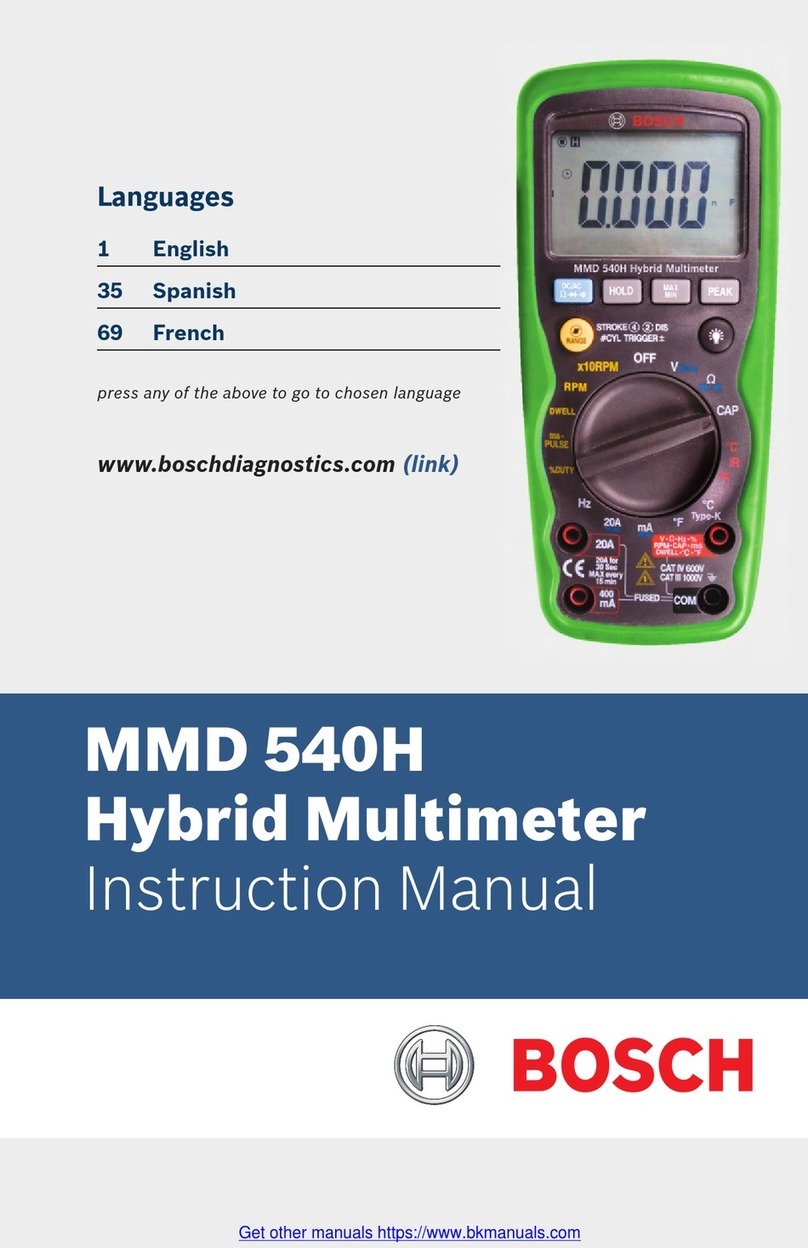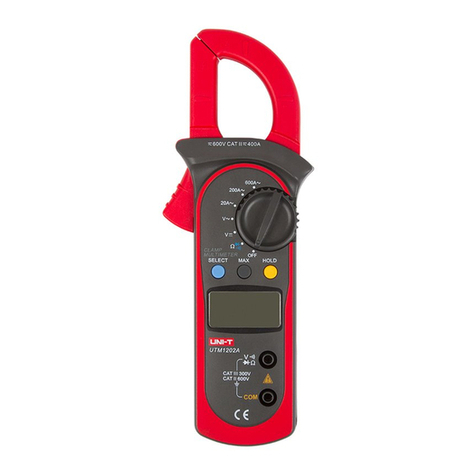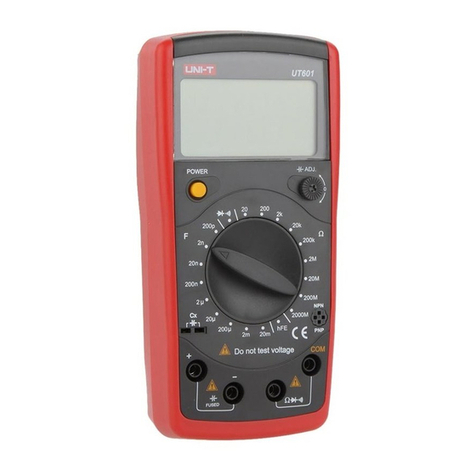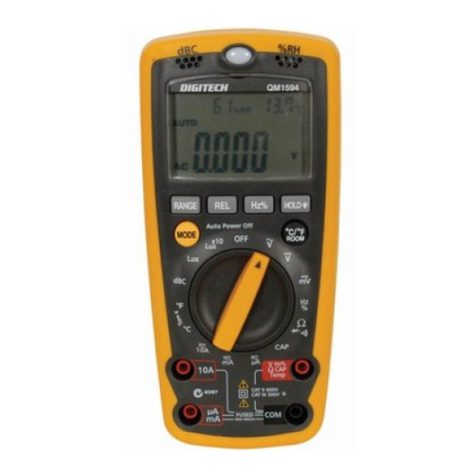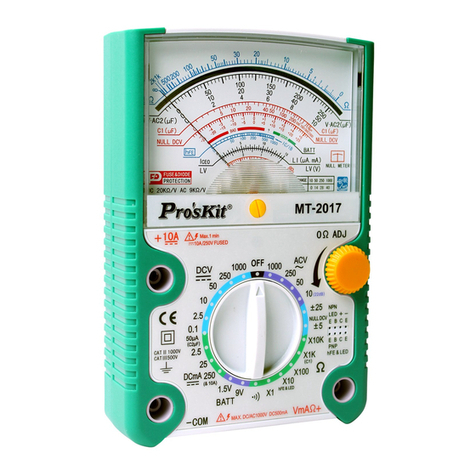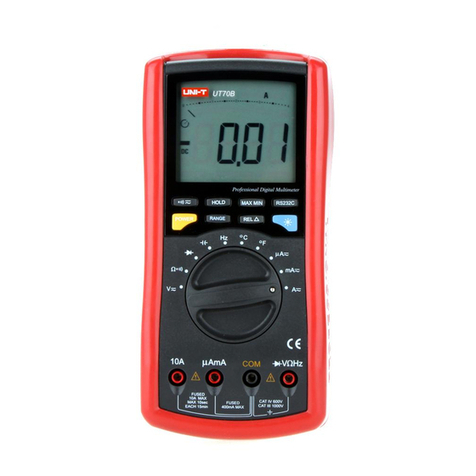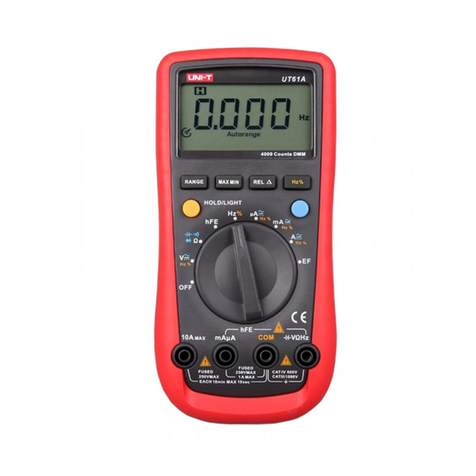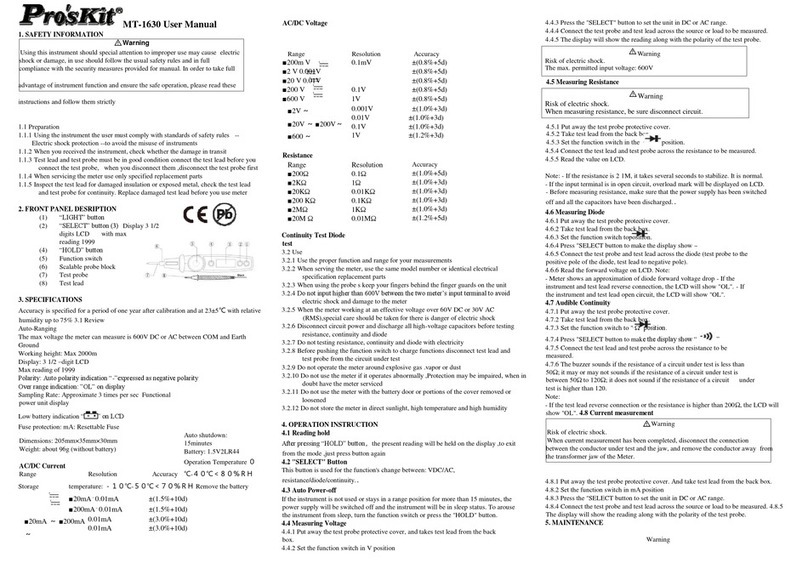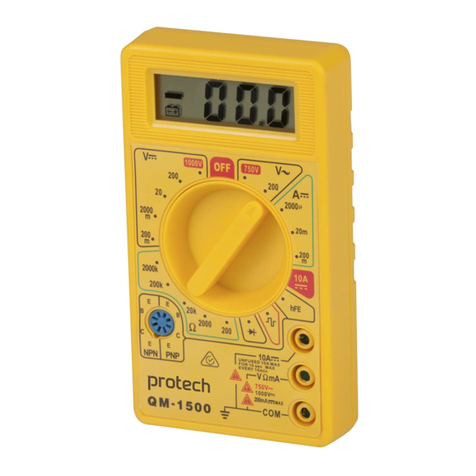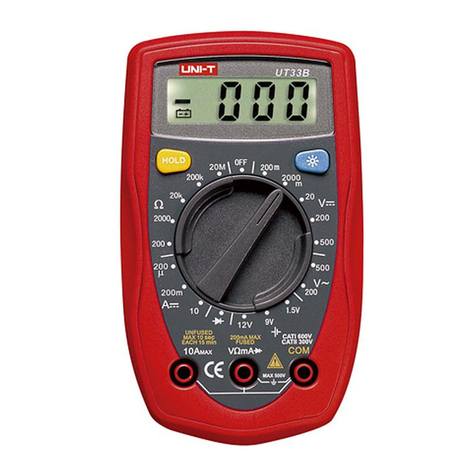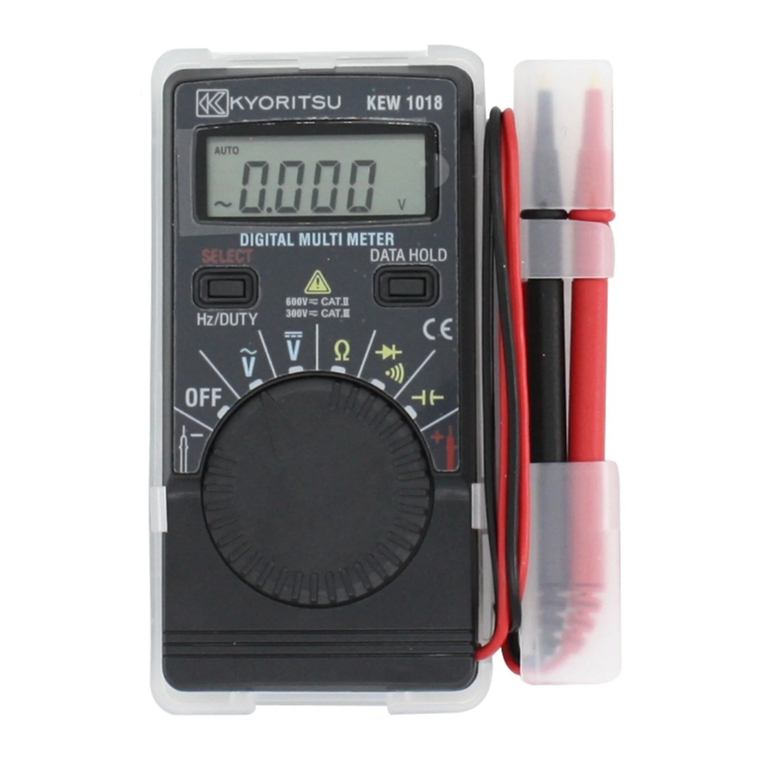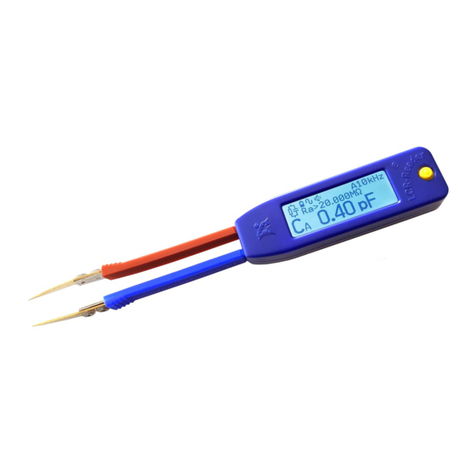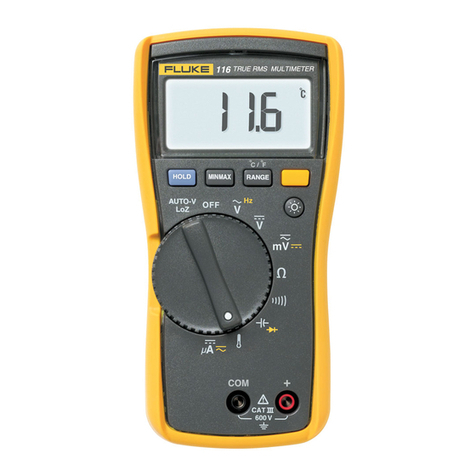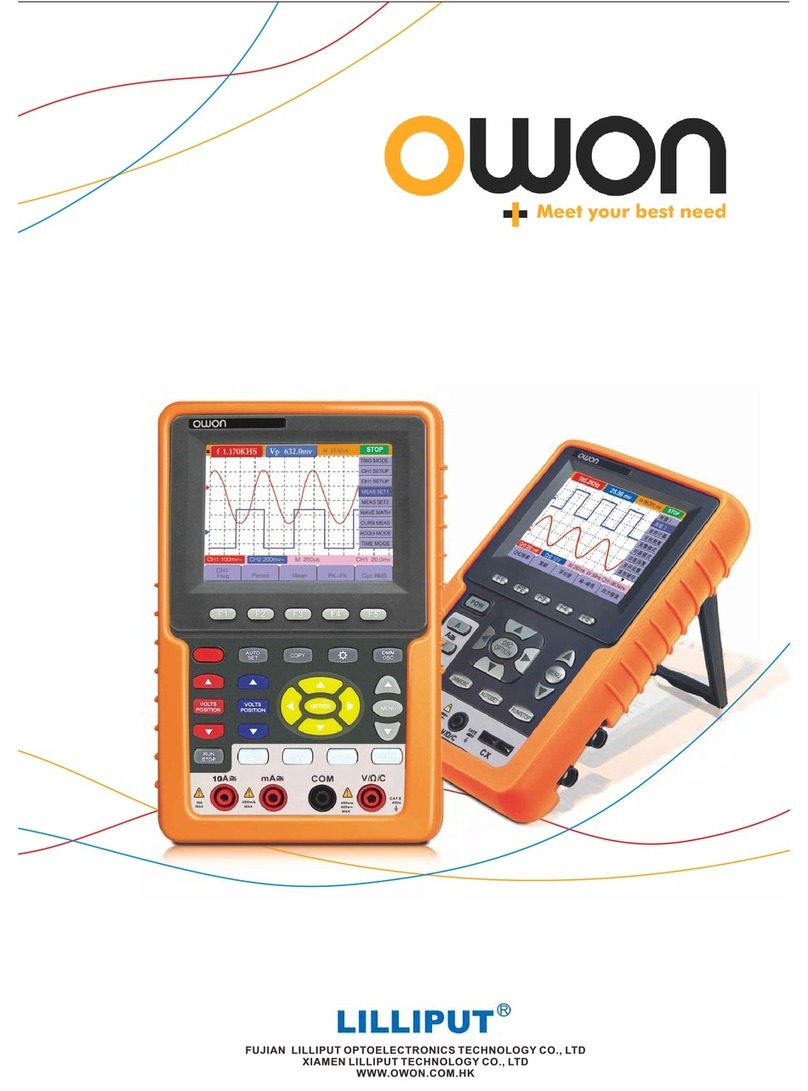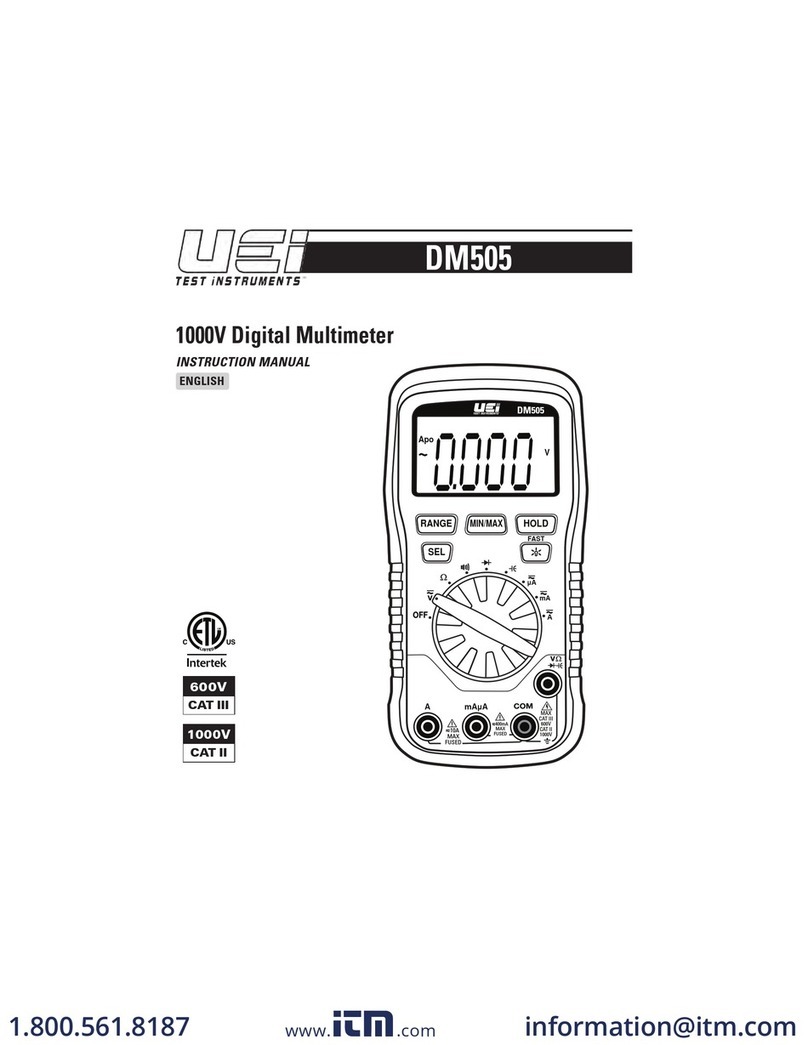Bosch MMD 302 User manual

MMD 302
de
Originalbetriebsanleitung
Digital Multimeter
en
Original instructions
Digital Multimeter
fr
Notice originale
Multimètre numérique
es
Manual original
Multímetro digital
it
Istruzioni originali
Multimetro digitale
MIN MAX REL HOLD
RANGE
PRW RST
H
OFF
V
V
ADPHz
4mA
40mA
400
mA
A
AmA VHz
MAX
CAT.III 600V
DC
AC
REL MAXMIN
MEM
mVA
C n u F
MK Hz
0
10
20
30
40
AUTO
H
456161-01_Ko
COM
MAX MAX
400mA
FUSED
FUSED
10 A cont.
20 A 30sec.

1 689 979 642 2014-11-03
|
Robert Bosch GmbH
| MMD 302 | 15
en
Contents English
1. Symbols used 16
1.1 In the documentation 16
1.1.1 Warning notices -
Structure and meaning 16
1.1.2 Symbols in this documentation 16
1.2 On the product 16
2. Safety instructions 16
2.1 Risk of electric shocks 16
2.1.1 Low voltages, high voltages 16
2.1.2 High voltages in hybrid vehicles and
electric vehicles as well as their
high-voltage components 17
2.2 Danger of fire, Danger of explosion 17
2.3 Danger of burning 17
2.4 Danger of tripping 17
2.5 Danger of injury, Danger of crushing 18
3. General Information 18
3.1 User profile 18
3.2 Application 18
3.3 Function description 18
3.4 Scope of delivery 18
3.5 Front View, operating elements and
connections 19
3.5.1 LCD 19
3.5.2 Blue function button 19
3.5.3 MIN MAX button 19
3.5.4 REL ∆-button 19
3.5.5 HOLD-button 20
3.5.6 PWR RST-button 20
3.5.7 RANGE-button 20
3.5.8 Measurement-mode switch 20
4. Connection and operation 20
4.1 Alternating and direct current
measurement 20
4.2 Acoustic continuity test and
resistance measurement 20
4.3 Capacitance measurement and
diode test 21
4.3.1 Capacitance measurement 21
4.3.2 Diode test 21
4.4 Frequency measurement 21
4.5 Current measurement 21
4.6 Possible uses of the protective
rubber cover 21
4.6.1 Single-handed multimeter 21
4.6.2 Measurement cables can be wrapped 22
4.6.3 Erecting 22
4.6.4 Protection 22
5. Maintenance 22
5.1 Cleaning 22
5.2 Spare parts and parts subject to wear 22
5.3 LCD difficult to read 22
5.4 0000 appears during current
measurement 23
5.5 Changing the batteries 23
5.6 Changing the fuses 24
6. Technical Data 24
6.1 General data 24
6.2 Measurement category as per EN61010 24
6.3 Meas. range, resolution and accuracy 25

1 689 979 642 2014-11-03
|
Robert Bosch GmbH
16 | MMD 302 | Symbols used
en
1. Symbols used
1.1 In the documentation
1.1.1 Warning notices - Structure and meaning
Warning notices warn of dangers to the user or people
in the vicinity. Warning notices also indicate the con-
sequences of the hazard as well as preventive action.
Warning notices have the following structure:
Warning
symbol
KEY WORD – Nature and source of hazard!
Consequences of hazard in the event of fail-
ure to observe action and information given.
¶Hazard prevention action and information.
The key word indicates the likelihood of occurrence and
the severity of the hazard in the event of non-obser-
vance:
Key word Probability of
occurrence
Severity of danger if in-
structions not observed
DANGER Immediate impend-
ing danger
Death or severe injury
WARNING Possible impending
danger
Death or severe injury
CAUTION Possible dangerous
situation
Minor injury
1.1.2 Symbols in this documentation
Symbol Designation Explanation
!Attention Warns about possible property damage.
iInformation Practical hints and other
useful information.
1.
2.
Multi-step
operation
Instruction consisting of several steps.
eOne-step
operation
Instruction consisting of one step.
Intermediate
result
An instruction produces a visible inter-
mediate result.
"Final result There is a visible final result on com-
pletion of the instruction.
1.2 On the product
!Observe all warning notices on products and ensure
they remain legible.
Instructions for your personal safety and
for the protection of equipment/vehicle
components
2. Safety instructions
2.1 Risk of electric shocks
2.1.1 Low voltages, high voltages
Hazardous voltages occur in both the lighting
system and the electrical system of a motor
vehicle. If contact is made with live parts
(e.g. with the ignition coil), there is a risk of
electric shock from flashover voltages caused
by damaged insulation (e.g. ignition cables
which have been attacked by martens). These
apply to the secondary and primary sides of
the ignition system, the wiring harness with
connectors, lighting system (Litronic) as well
as connection to the vehicle.
Safety measures:
¶Only connect to a properly grounded outlet.
¶Only the enclosed or a tested power supply cable is
to be used.
¶All extension cables must be fitted with shock-proof
contacts.
¶Do not exceed the voltage limits as specified on the
connection cables.
¶Any cables with damaged insulation must be re-
placed.
¶Before connecting it to the vehicle, first connect the
product to the lighting mains and switch on.
¶Before switching on the ignition connect the (B-)
cable to engine ground or the battery (B–) terminal.
¶Always switch off the ignition before performing any
work on the electrical system of the vehicle. Inter-
vention includes, for instance, connection to the
vehicle, replacement of ignition system components,
removal of equipment (e. g. alternators), connection
of equipment to a test bench.
¶Wherever possible, tests and settings should always
be caried out with the ignition switched off and the
engine stationary.
¶If tests or settings are carried out with the ignition
switched on or the engine running, care must be
taken not to touch any live parts. This applies to all
connection cables and leads as well as to connec-
tions of equipment to test benches.
¶Test connections must always be made using suit-
able connectors (e.g. Bosch testing cable set or
vehicle-specific adapter cables).
¶Make sure that all test connections are properly
plugged in and secure.
¶Before disconnecting the (B-) cable from the engine
ground or battery (B–), switch off the ignition.
¶Never open the enclosures.
Disposal
Dispose of used electrical and electronic
devices, including cables, accessories and
batteries, separately from household waste.

1 689 979 642 2014-11-03
|
Robert Bosch GmbH
Symbols used | MMD 302 | 17
en
2.2 Danger of fire, Danger of explosion
There is a risk of fire and explosion from fu-
els and fuel vapors when work is performed
on the fuel system or on the mixture control
system.
Safety measures:
¶Switch off the ignition.
¶Allow the engine to cool down first.
¶Avoid naked flames and potential sources of sparks.
¶Do not smoke.
¶Collect any leaked fuel.
¶Always ensure effective ventilation and suction when
working in closed areas.
2.3 Danger of burning
When working on a hot engine, there is a risk
of injury from burning if such components as
the exhaust gas manifold, the turbo-charger,
the Lambda sensor, etc. are touched or if
parts of the body come too close to them.
These components may be heated to tem-
peratures of several hundred degrees Celsius.
Depending on the duration of the exhaust
gas measurements, the sampling probe of the
exhaust gas measuring instrument may also
become extremely hot.
Safety measures::
¶Always wear protective clothing, e.g. gloves.
¶Allow the engine to cool down first. This also applies
to auxiliary heating systems.
¶Keep connecting cables well away from all hot parts.
¶Do not leave the engine running any longer than
necessary for the test or setting.
2.4 Danger of tripping
When conducting tests or making adjust-
ments, the sensor and connection cables in-
crease the risk of tripping.
Safety measures:
¶Route the connecting cables such that any risk of
tripping up is prevented.
2.1.2 High voltages in hybrid vehicles and electric ve-
hicles as well as their high-voltage components
If high-voltage components or high-voltage
wires are inexpertly handled, there is a risk of
fatal injury from high voltages and the possi-
ble transmission of current through the body.
¶Deenergization is only to be performed by
a qualified electrician, a qualified electri-
cian for specific tasks (hybrid) or a power
systems engineer.
¶Work on vehicles with high-voltage com-
ponents is only ever to be performed in
a safe, deenergized condition by persons
with the minimum qualification "Trained to
perform electrical work".
¶Even after deactivating the high-voltage
vehicle electrical system, the high-voltage
battery may still be live.
¶Operating condition cannot be established
from any running noise, as the electric ma-
chine is silent when stationary.
¶In gear positions "P" and "N" the engine
or electric motor may start spontaneously
depending on the charge of the high-voltage
battery.
Safety measures:
¶Never open or damage high-voltage batteries.
¶On accident vehicles, never touch high-voltage com-
ponents or exposed high-voltage wires before deac-
tivating the high-voltage vehicle electrical system.
¶Avoid contact with any high-voltage components
and high-voltage wires (orange sheathing) when in
operation.
¶Secure against unauthorized renewed start-up
(e.g. by means of a padlock).
¶Always wait at least 10 seconds after deactivating
the high-voltage system.
¶Visually inspect the high-voltage components and
high-voltage wires for damage. The power systems
engineer responsible should always be immediately
notified of any irregularities, doubts or defects
found.
$High-voltage components must never exhibit signs
of external damage.
$The insulation of the high-voltage wiring must be
intact and undamaged.
$Watch out for any abnormal deformation of the
high-voltage wiring.

1 689 979 642 2014-11-03
|
Robert Bosch GmbH
18 | MMD 302 | General Information
en
2.5 Danger of injury, Danger of crushing
The vehicle has rotating and moving parts
that can injure fingers and arms.
If the vehicle is not prevented from roll-
ing away, there is a danger of people being
crushed against a workbench, for example.
There is the risk with electrically operated
fans in particular that the fan can start run-
ning unexpectedly even when the engine and
ignition are off.
Safety measures:
¶Take steps to prevent the vehicle from rolling away
while it is being tested. Select the park position if the
vehicle has an automatic transmission and apply the
handbrake or lock the wheels with chocks (wedges).
¶Deactivate the start/stop system when working on a
vehicle in order to prevent uncontrolled engine start.
¶Operating staff must wear work clothes without
loose bands and loops.
¶Do not reach in any area with rotating or moving parts.
¶When working on or in the vicinity of electrically
driven fans, allow the engine to cool down first, then
disconnect the plug of the fan motor.
¶Route cables at a suitable distance from rotating parts.
¶Secure the trolley against rolling away by setting the
brakes.
¶Do not place heavy objects on or lean on the sensor
holder.
¶Transport and operate the equipment only in accor-
dance with the operating instructions.
3. General Information
3.1 User profile
The MMD 302 was designed for trained, specialised
personnel such as mechanics, electricians, technicians
and engineers in the area of automotive engineering.
3.2 Application
!The MMD 302 is only intended for indoor use.
The MMD 302 is a measuring device for:
RDirect and alternating voltage measurement
RContinuity test (acoustic) and resistance
measurement
RCapacitance and diode test
RFrequency measurement
RAlternating and direct current measurement
RMIN./MAX. operating mode, recording and storage of
minimum and maximum mea- sured values
RREL-∆ operating mode, display of the difference be-
tween current and stored measured value
RHOLD-function for "freezing" the display
3.3 Function description
The MMD 302 (MMD = Multimeter Digital) is a com-
pact and battery-operated digital multimeter. It has a
3 3/4-digit display with an additional analog display,
which consists of 42 segments. It has an automatic
device-shut-down circuit, which is actuated approx.
30minutes after the last button is pressed (in order to
spare the batteries).
3.4 Scope of delivery
RMMD 302 digital multimeter
RRed measuring cable with test probe
RBlack measuring cable with test probe
RRed connecting terminal
RBlack connecting terminal
RProtective rubber cover with stand
R2 commercially available dry batteries (installed) 1.5 V
Micro type / AAA / AM4 / LR03 / MN2400-1.5 V
ROperating instructions
The accessories provided are only to be used
in conjunction with the MMD 302 and for
voltages lower than the value marked on the
accessories. When combining accessories
with the MMD 302, care must be taken not to
exceed the lowest marked voltage value in the
measurement chain.

1 689 979 642 2014-11-03
|
Robert Bosch GmbH
General Information | MMD 302 | 19
en
3.5 Front View, operating elements and
connections
MIN MAX REL
MIN MAXPRW RST
OFF
V
V
ADPHz
4mA
40mA
400
mA
A
AmA
VHz
DC
AC
REL MAXMIN
MEM
mVA
C n u F
MK Hz
0
10
20
30
40
121110
1
4
32
7
6
8
AUTO
HOLD
H
H
5
456163-01_Ko
9
COM
MAX
CAT.III 600V
MAX MAX
400mA
FUSED
FUSED
10 A cont.
20 A 30sec.
Fig. 1: Front view MMD 302
1 LCD
2 Blue function button
3 MIN./MAX. button
4 REL- button
5 HOLD-button
6 PWR RST button
7 RANGE button
8 Measuring-mode switch
9 Test input for the 10A measuring range
10 Test input for the mA measuring ranges
11 Earth input, used for all measuring modes
12 Test input for alternating voltage, direct voltage, continuity test,
resistance measurement, capacitance measure- ment, diode
testing, frequency measurement
3.5.1 LCD
Consisting of:
RAnalog display (42 segments), displays the current
measured value
RDigital display (display range, 3999), the display
of the measured value depends on the selected
measurement mode (selected by means of measure-
ment-mode switch and function button)
3.5.2 Blue function button
Depending on the position of the measurement-mode
switch, pressing this function button switches between:
RContinuity test and resistance measure- ment
RCapacitance measurement and diode test
RFrequency measurement
RDirect and alternating current measurement
3.5.3 MIN MAX button
RThe minimum memory is activated by pressing the
button once (the smallest measured value is saved
and displayed).
RThe maximum memory is activated by pressing the
button again or twice (the greatest measured value
is saved and displayed). The MIN/MA measured val-
ues appear in the digital display.
RThe appearance of MIN or MAX symbols on the LCD
indicates whether the minimum or maximum memo-
ry respectively has been activated.
RThe analog display always indicates the current
measured value.
RMeasurement is "frozen" by pressing the HOLD but-
ton (fig. 1, pos. 5). Measurement resumes by press-
ing the button again.
RYou leave the MIN./MAX. mode by pressing the
RANGE-button (fig. 1, pos. 7) for approx. 2seconds.
3.5.4 REL ∆-button
RBy pressing the button once, the current measured
value is saved and the digital display is set to 0000.
REL appears in the display. The value now displayed
represents the differential between the measured
and saved values.
RThe analog display always shows the current mea-
sured value.
RYou can exit the REL-∆ mode by pressing the RANGE-
button (fig. 1, pos. 7) for approx. 2seconds.

1 689 979 642 2014-11-03
|
Robert Bosch GmbH
20 | MMD 302 | General Information
en
3.5.5 HOLD-button
RThe current display is "frozen" when this button is
pressed. This is indicated by the appearance of the
H symbol.
RPress the HOLD-button again in order to cancel the
HOLD function.
iThe automatic appliance-shut-off function is deacti-
vated during HOLD mode.
3.5.6 PWR RST-button
The MMD 302 switches off automatically approx.
30 minutes after the last button or the measurement-
mode switch is actuated.
iThe unit is switched back on again by pressing the
PWR RST-button.
3.5.7 RANGE-button
RThis RANGE-button allows you to set a certain mea-
surement range. In order to return to the automatic
measurement-range changeover function, press the
RANGE-button (approx. 2 seconds) until AUTO ap-
pears in the display.
RYou can exit the REL- and MIN./MAX. mode by press-
ing the RANGE-button for approx. 2 seconds.
3.5.8 Measurement-mode switch
Selecting the desired measurement mode and switch-
ing off the appliance.
place Function / Meaning
OFF Switch position when the appliance is switched off
V~ Measurement of alternating voltage
V= Measurement of direct voltage
Continuity test or resistance measurement
(changeover by means of the blue function button)
Capacitance measurement or diode test (change-
over by means of the blue function button)
ADP Hz Hz = frequency measurement
ADP = no function
4 mAMeasurement of direct and alternating current up
to 4 mA (changeover between direct and alternat-
ing current by means of the blue function button)
40 mAMeasurement of direct and alternating current up to
40 mA (change-over between direct and alternating
current by means of the blue function button)
400 mAMeasurement of direct and alternating current up to
400 mA (changeover between direct and alternating
current by means of the blue function button)
AMeasurement of direct and alternating current up
to 10 A (changeover between direct and alternat-
ing current by means of the blue function button)
4. Connection and operation
The following applies to all measuring modes and
ranges:
!The correct measuring mode must first be selected
in order to prevent damage to the measuring appli-
ance. Only then may the measuring cables be con-
nected to the measuring object!
1. Connect the black measuring cable to the earth
input (fig. 1, pos. 11).
2. A pulsating buzzer warning signal is emitted if a
measuring range is exceeded. In addition, 4000
appears in the display, and the highest value digit
flashes.
3. Negative polarity of the input value is identified by a
"–" before the measured value.
4.1 Alternating and direct current
measurement
1. Connect the red measuring cable to the test input
for voltage measurement (fig. 1, pos. 12).
2. Turn the measurement-mode switch (fig. 1, pos.
8) to the desired position for alternating or direct
voltage. In the display, AC is shown for alternating
voltage and DC for direct voltage.
3. Connect the test probes parallel to the measure-
ment object.
4.2 Acoustic continuity test and
resistance measurement
1. Connect measuring cable to test input for
resistance measurement (fig. 1, pos. 12).
2. Turn measurement-mode switch (fig. 1, pos. 8) to
the position.
3. You can switch from acoustic continuity test to resis-
tance measurement by means of the blue function
button (fig. 1, pos. 2). In the display, is shown for
acoustic continuity test and Ω for resistance mea-
surement.
!Switch off the power supply to the measurement
object and discharge the condensers (capacitors),
as the MMD 302 could otherwise be dama- ged!
4. Connect the test probes parallel to the
measurement object.
5. A buzzing sound occurs in the acoustic continuity
test mode for resistance values less than 35 Ω.

1 689 979 642 2014-11-03
|
Robert Bosch GmbH
Connection and operation | MMD 302 | 21
en
4.3 Capacitance measurement and
diode test
4.3.1 Capacitance measurement
1. Connect red measuring cable to test input for ca-
pacitance measurement (fig. 1, pos. 12).
2. Turn measurement-mode switch (fig. 1, pos. 8) to the
position.
3. nF appears in the display.
4. Discharge the condenser (capacitor) and connect to
the test probes.
4.3.2 Diode test
1. Connect red measuring cable to test input for diode
test (fig. 1, pos. 12).
2. Turn measurement-mode switch (fig. 1, pos. 8)
to the position, and switch to diode test by
means of the blue function button (fig. 1, pos. 2).
The diode symbol and a voltage value of approx. 3 V
appear in the display.
3. Connect the test probes to the diode as follows:
Connect the black test probe to the cathode and the
red probe to the anode. The measured value now
shown should be between 0.5 V and 0.9 V. If the
displayed value is clearly above or below the quoted
levels, the diode is faulty.
4. Connect the black test probe to the anode and the
red probe to the cathode. The measured value now
shown should be the same as when the test probes
are not connected (approx. 3 V). The diode is faulty
if the measuring device gives a different reading.
4.4 Frequency measurement
1. Connect red measuring cable to test input for volt-
age measurement (fig. 1, pos. 12).
2. Turn measurement-mode switch (fig. 1, pos. 8)
to ADPHz position, and switch over to frequency
measurement by means of the blue function button
(fig.1, pos. 2). Hz appears in the display.
4.5 Current measurement
!Always observe the current limit values of the se-
lected measuring range and at the test inputs.
iIn the case of all current measurement ranges, the
blue function button (fig. 1, pos. 2) is used to switch
over from alternating to direct current. In the dis-
play, AC appears for alternating and DC for direct
current.
1. Connect the red cable to the test input for the ap-
propriate measuring range.
2. Turn the measurement-mode switch (fig. 1, pos. 8)
to the desired position.
3. Switch off the power supply to the measure- ment
object and open the current circuit to be measured.
4. Connect the test probes in series with the measure-
ment object.
Currents up to 400 mA
1. Connect red measuring cable to test input for mA
(fig. 1, pos. 10).
2. Turn measurement-mode switch (fig. 1, pos. 8) to
the desired position (4mA, 40mA, 400mA).
Currents from 400 mA to 20 A
!Currents in excess of 10 A must not be measured for
longer than 30 seconds. A 3-minute measurement
interval must be allowed after this period.
1. Connect red measuring cable to test input for A (fig. 1,
pos. 9).
2. Turn measurement-mode switch (fig. 1, pos. 8) to
position A.
4.6 Possible uses of the protective
rubber cover
4.6.1 Single-handed multimeter

1 689 979 642 2014-11-03
|
Robert Bosch GmbH
22 | MMD 302 | Connection and operation
en
4.6.2 Measurement cables can be wrapped
iMeasurement cables can be wrapped around the
appliance and secured in the measurement cable
holders.
4.6.3 Erecting
iWith the protective rubber cover, the appliance can
be erected on a level surface or suspended on a
door or a nail.
4.6.4 Protection
iThe measuring device can also be inserted back to
front in the protective rubber cover in order to pro-
tect the LCD against scratching when not in use.
5. Maintenance
!The MMD 302 is not to be repaired. The MMD 302 has
no parts of any use to the user. Repairs can only be
performed by qualified customer service personnel.
5.1 Cleaning
!Always switch off the MMD 302 for cleaning.
The housing and the LCD of the MMD 302 are only
to be cleaned using a soft cloth and neutral cleaning
agents. Do not use abrasive cleaning agents and coarse
workshop cloths. The rubber cover can be removed for
cleaning purposes.
Do not use alcohol-based cleaning agents, as these
could leave residue.
5.2 Spare parts and parts subject to
wear
Designation Part Number
Cable set, red and black measuring cables 1 687 011 323
Connecting terminal, red 1 681 354 023
Connecting terminal, black 1 681 354 024
Protective rubber cover 1 680 591 026
1A/600V IR 10KA fast active fuse, Buss-
mann BBS-1 or similar rating
1 684 520 023
15A/600V IR 10KA fast active fuse, Buss-
mann KTK 15 or similar rating
1 684 520 024
Rubber seal for housing 1 681 006 031
5.3 LCD difficult to read
If the LCD is difficult to read after the appliance has
been switched on, you should check the batteries as
follows:
Turn the measurement-mode switch (fig. 1, pos. 8) to
the position, and switch over to diode testing by
means of the blue function button(fig. 1, pos. 2). The
battery voltage is now displayed. The displayed voltage
should be between 2.8 V and 3.2 V in order to guar-
antee safe operation of the MMD 302. The batteries
should be changed if this value lies below 2.5 V.

1 689 979 642 2014-11-03
|
Robert Bosch GmbH
Maintenance | MMD 302 | 23
en
5.4 0000 appears during current
measurement
The current-measuring ranges of the MMD 302 are pro-
tected against overloading by two built-in fuses. If the
measured value reads 0000 during current measure-
ment, the fuses must be checked as follows:
1. Switch off the power supply to the measuring object
and remove the measuring cables.
2. Connect the red cable to the test connection of
diode testing (fig. 1, pos. 12).
3. Turn the measurement-mode switch (fig. 1, pos. 8)
to the position, switch over to diode testing
by means of the blue function button(fig. 1, pos. 2).
4. The battery voltage and the diode symbol appear in
the display.
Testing the fuse for the mA ranges
¶Connect the red test probe to the test connection
for mA (fig. 1, pos. 10).
"The indicated value should be approx. 1.5 V. If the
displayed value remains unchanged (approx. 3 V), the
F1 fuse is faulty and must be replaced.
Testing the fuse for the A range
¶Connect the red test prove to the test connection
for A (fig. 1, pos. 9).
"The indicated value should be approx. 0 V. If the dis-
played value remains unchanged (approx. 3 V), the F2
fuse is faulty and must be replaced.
5.5 Changing the batteries
The batteries may only be changed when the
MMD 302 is not connected to a measurement
object!
Fig. 2: Changing the batteries
1 Housing upper section
2 Housing lower section
3 Protective rubber
4 Battery holder
5 1.5 V battery
1. Remove measuring cables from the measuring object
and the MMD 302.
2. Turn the measurement-mode switch to the OFF posi-
tion.
3. Remove the three screws from the back of the appli-
ance.
4. Lift the lower end of the housing lower section until it
clicks out of the housing upper section.
5. Remove the battery holder.
6. Remove protective rubber and empty batteries.
7. Insert new batteries (type, Micro / AAA / AM4 / LR03
/ MN2400-1.5 V).
!The discharged batteries constitute special waste
and must be disposed of accordingly!
8. Slide the protective rubber back over the battery
holder.
9. Reinsert the battery holder in the appliance. When
reassembling the appliance, ensure that the battery
cables are not crushed.
10.Check that the O-ring and the rubber seal are
positioned correctly between the upper and lower
housing sections.
11.Reattach lower housing section. Ensure that it clicks
into place at the upper end of the housing.
12.Reinsert and tighten the three screws.

1 689 979 642 2014-11-03
|
Robert Bosch GmbH
24 | MMD 302 | Maintenance
en
6. Technical Data
6.1 General data
Designation Value
Measurement speed Digital displays 2second
analog displays 20/second
Automatic appliance shut-off Approx. 30minutes after
last switch is pressed
Operating temperature 10 °C bis +40 °C
Storage temperature -20 °C bis +60 °C
Temperature coefficient 0.1 x specific accuracy/°C
(<18 °C or <28 °C)
Relative humidity 0 % to 80 %
(0 °C to 50 °C)
Maximum usage altitude 2000 m
Type of protection IP 20
Voltage supply 2 commercially available
dry batteries, 1.5 V Type Mi-
cro / AAA / AM4/ LR03 /
MN2400-1.5 V
Battery life Approx. 1,000 hours with al-
kaline-manganese batteries
Dimensions
Without protective rubber cover:
with protective rubber cover:
185 mm x 86 mm x 32 mm,
200 mm x 98 mm x 52 mm
Weight
Without protective rubber cover
with protective rubber cover
370 g
600 g
6.2 Measurement category as per
EN61010
EN 61010-2-033:2012 specifies the general safety re-
quirements for hand-held measuring instruments and
defines the measurement categories from 0 to IV.
Both the MMD 302 and the terminals and measurement
cables supplied are designed for test and measurement
circuits of categoryIII. The maximum permissible volt-
ages for CAT III = 600V must never be exceeded.
5.6 Changing the fuses
The fuses may only be changed when the
MMD 302 is not connected to a measurement
object!
!Only fuses with the following specifications may be used:
$Fuse F1: 1 A/600 V IR 10KA fast acting fuse (Buss-
mann BBS-1, Littelfuse BLS 1 A or similar rating)
Dimensions: 10.3 x 35 mm
$Fuse F2: 15 A/600 V IR 10KA fast acting fuse
(Bussmann KTK 15, Littelfuse KLK 15A or similar
rating)
Dimensions: 10.3 x 38 mm
Fig. 3: Changing the fuses
1 Housing upper section
2 Housing lower section
3 F1 (1A/600V)
4 F2 (15A/600V)
1. Disconnect the measuring cables from the measure-
ment object and the MMD 302.
2. Turn the measurement-mode switch to the OFF position.
3. Remove the three screws from the back of the appliance.
4. Lift the lower end of the housing lower section until
it clicks out of the housing upper section.
5. Remove the battery holder.
6. Lift the PCBs vertically out of the housing upper
section.
7. Replace faulty fuse.
8. Reinsert PCBs.
9. Reinsert the battery holder in the appliance. During
reassembly, ensure that the battery cables are not
crushed.
10. Check the o-rings and the rubber seal are positioned cor-
rectly between the housing upper and lower sections.
11. Reattach the housing lower section. Ensure that it
clicks into position at the upper end of the housing.
12. Reinsert and tighten the three screws.

1 689 979 642 2014-11-03
|
Robert Bosch GmbH
Maintenance | MMD 302 | 25
en
6.3 Meas. range, resolution and accuracy
Meas. Range Resolution Accuracy Max. Input
Direct voltage*
400 mV
4 V
40 V
500 V
0,1 mV
1 mV
0,1 V
1 V
±(0,3% +2 digit)
±(0,1% +2 digit)
±(0,1% +2 digit)
±(0,1% +2 digit)
500 V
500 V
500 V
500 V
Alternative voltage*
50 Hz – 60 Hz
400 mV
4 V
40 V
500 V
0,1 mV
1 mV
0,1 V
1 V
±(0,8% +5 digit)
±(0,8% +5 digit)
±(0,8% +5 digit)
±(0,8% +5 digit)
500 V
500 V
500 V
500 V
Alternative voltage*
40 Hz – 1 kHz
400 mV
4 V
40 V
500 V
0,1 mV
1 mV
0,1 V
1 V
±(1% +5 digit)
±(1% +5 digit)
±(1% +5 digit)
±(1% +5 digit)
500 V
500 V
500 V
500 V
Direct current (direct)
4 mA
40 mA
400 mA
10 A
1 µA
10 µA
0,1 mA
10 mA
±(0,4% +2 digit)
±(0,4% +2 digit)
±(0,4% +2 digit)
±(0,8% +4 digit)
3,999 mA **
39,99 mA **
399,9 mA **
10 A ***
Alternative current (direct)
40 Hz – 1 kHz
4 mA
40 mA
400 mA
10 A
1 µA
10 µA
0,1 mA
10 mA
±(1% +5 digit)
±(1% +5 digit)
±(1% +5 digit)
±(1% +5 digit)
3,999 mA **
39,99 mA **
399,9 mA **
10 A ***
Continuity test****
Buzzer (till 2kHz)
400 Ω
0,1 Ω< 40 Ω399,9 Ω
Resistance****
400 Ω
4 kΩ
40 kΩ
400 kΩ
4 MΩ
40 MΩ
0,1 Ω
1 mΩ
10 mΩ
0,1 Ω
1 kΩ
10 kΩ
±(0,4% +3 digit)
±(0,4% +2 digit)
±(0,4% +2 digit)
±(0,4% +2 digit)
±(0,6% +3 digit)
±(1,5% +5 digit)
399,9 Ω
3,999 kΩ
39,99 kΩ
399,9 kΩ
3,999 MΩ
39,99 MΩ
Diode test*****
3,0 V 1 mV
* Impedance: 10 MΩ, less than 100 pF,
Voltage drop: maximal 800 mV for mA-test input; maximal 1 V for A-test input
Test input protection:
** Fuse F1: 1 A 600 V IR 10KA fast acting fuse (Bussmann BBS-1, Littelfuse BLS 1 A or similar)
*** Fuse F2: 15 A 600 V IR 10KA fast acting fuse (Bussmann KTK 15, Littelfuse KLK 15 A or similar)
**** Idle test voltage: approx. 0.4 V
***** Idle test voltage: approx. 3 V, measuring current: 0.6 mA
Meas. Range
Resolution Accuracy Max. Input
Condenser test
4 nF
40 nF
400 nF
4 µF
40 µF
40 µF
1 pF
10 pF
0,1 nF
1 nF
10 nF
10 nF
±(1% + 40 digit)
±(1% + 4 digit)
±(1% + 4 digit)
±(1% + 4 digit)
±(1% + 4 digit) 20µF
±(5% + 8 digit) >20µF
Frequency*
automatic range
changeover only
100 Hz
1 kHz
10 kHz
100 kHz
1 MHz
0,01 Hz
0,1 Hz
1 Hz
10 Hz
100 Hz
±(0,1% +4 digit)
±(0,1% +4 digit)
±(0,1% +4 digit)
±(0,1% +4 digit)
±(0,1% +4 digit)
500 V
* Sensitivity: 40 mV rms for 1 Hz approx. 20 kHz, 400 mV rms for 20 kHz approx. 1 MHz

Robert Bosch GmbH
Automotive Service Solutions
Franz-Oechsle-Straße 4
73207 Plochingen
DEUTSCHLAND
www.bosch.com
1 689 979 642 | 2014-11-03
Table of contents
Other Bosch Multimeter manuals

